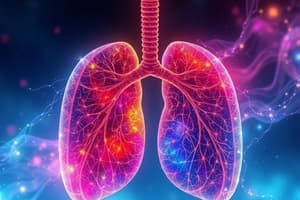Podcast
Questions and Answers
What is the primary role of respiratory pigments in gas transport?
What is the primary role of respiratory pigments in gas transport?
- To convert gases into liquid form
- To enhance the rate of muscle contraction
- To create energy through chemical reactions
- To bind and transport gases like O2 (correct)
What type of protein is myoglobin, and how does it function?
What type of protein is myoglobin, and how does it function?
- A monomeric protein that contains one heme group (correct)
- A soluble protein found primarily in plasma
- A polymeric protein that transports carbon dioxide
- A dimeric protein that binds four oxygen molecules
What distinctive characteristic is associated with hemocyanins when they bind oxygen?
What distinctive characteristic is associated with hemocyanins when they bind oxygen?
- They turn blue upon binding (correct)
- They become red upon binding
- They turn green upon binding
- They remain colorless upon binding
How many heme-globin subunits does hemoglobin contain in mammals?
How many heme-globin subunits does hemoglobin contain in mammals?
What is the significance of the non-linear (sigmoidal) binding of O2 to hemoglobin?
What is the significance of the non-linear (sigmoidal) binding of O2 to hemoglobin?
Which of the following is characteristic of chlorocruorins?
Which of the following is characteristic of chlorocruorins?
What is the status of O2 in terms of partial pressure when it binds to hemoglobin?
What is the status of O2 in terms of partial pressure when it binds to hemoglobin?
What role does leghemoglobin play in plants, especially in legumes?
What role does leghemoglobin play in plants, especially in legumes?
What effect does a high partial pressure of oxygen (PO2) have on hemoglobin (Hb) binding?
What effect does a high partial pressure of oxygen (PO2) have on hemoglobin (Hb) binding?
What is the significance of the P50 value in hemoglobin behavior?
What is the significance of the P50 value in hemoglobin behavior?
Why does oxygen unbind from hemoglobin at exercising muscle?
Why does oxygen unbind from hemoglobin at exercising muscle?
What is one reason that myoglobin (Mb) does not exhibit cooperativity in oxygen binding?
What is one reason that myoglobin (Mb) does not exhibit cooperativity in oxygen binding?
How does the internal environment affect hemoglobin's binding to oxygen?
How does the internal environment affect hemoglobin's binding to oxygen?
What happens to oxygen as blood passes through a muscle that contains myoglobin?
What happens to oxygen as blood passes through a muscle that contains myoglobin?
What adaptation allows some animals to thrive in low oxygen environments?
What adaptation allows some animals to thrive in low oxygen environments?
What is a characteristic change in hemoglobin binding at high PO2?
What is a characteristic change in hemoglobin binding at high PO2?
What adaptation allows smaller mammals to survive in high altitude environments?
What adaptation allows smaller mammals to survive in high altitude environments?
What is the primary effect of organic phosphates on hemoglobin (Hb)?
What is the primary effect of organic phosphates on hemoglobin (Hb)?
How does acclimation to high altitude affect hematocrit in mammals?
How does acclimation to high altitude affect hematocrit in mammals?
Which form of globin is primarily expressed in mammalian fetuses to adapt to oxygen availability?
Which form of globin is primarily expressed in mammalian fetuses to adapt to oxygen availability?
What physiological change occurs to hemoglobin at working muscles compared to the lungs?
What physiological change occurs to hemoglobin at working muscles compared to the lungs?
What is the Bohr effect in relation to hemoglobin?
What is the Bohr effect in relation to hemoglobin?
Which of the following is NOT a characteristic of hemoglobin acclimation?
Which of the following is NOT a characteristic of hemoglobin acclimation?
What role do temperature changes play in the function of hemoglobin?
What role do temperature changes play in the function of hemoglobin?
Study Notes
Respiratory Pigments & Gas Diffusion
- Gases combined chemically with other molecules do not contribute to partial pressure
- Impacts diffusion
- Example of a chemical combination: CO2 + H2O H2CO3 H+ + HCO3-
- Example of another chemical combination: Hb H + O2 ՞ Hb O2 + H+
Oxygen Transport: Respiratory Pigments
- Heme: porphyrin ring complexed with one iron atom
- Myoglobin (Mb): monomeric protein (globin) plus one heme molecule with one oxygen binding site
- Typically found in muscle tissue
Pigment Diversity
- Chlorocruorins: use iron and a different porphyrin ring from Mb, Hb
- Bind oxygen and turn green
- Found in four marine annelid worm families including feather duster worms
Pigment Diversity
- Hemerythrins: non-porphyrin, iron-containing proteins found within muscle and blood cells with two oxygen binding sites
- Found in some types of worms and brachiopods including sipunculid worms and brachiopod molluscs
Pigment Diversity
- Hemocyanins: copper containing, non-porphyrin proteins with up to 160 oxygen binding sites
- Bind oxygen and turn blue
- Found extracellularly in some molluscs and arthropods including decapod crustaceans (lobster) and cephalopod molluscs (squid)
Pigment Diversity: Plants
- Leghemoglobin: monomeric (like Mb), porphyrin ring, globin protein
- In legumes supplies O2 for symbiotic bacteria, which fix N2 for the plant
- Found in soybean root nodules
Hemoglobin (Hb)
- Found in the blood cells of most vertebrates
- Up to four heme-globin subunits
- Mammals have 2 α, 2 β subunits
Oxygen – Hb Binding: Key Points
- Equilibrium reaction:
- Higher PO2, more binding
- Low PO2, O2 unbinds from Hb
- O2 – binding non-linear (sigmoidal)
- O2 only available to tissue if unbound
- Binding/unbinding affected by internal environment – acute effects: Temp., pH, CO2
1: Equilibrium Binding
- Higher PO2, more binding
- Low PO2, O2 unbinds from Hb
- PO2 falls in blood due to a decrease in pressure or oxygen depletion
- Very little O2 dissolved in blood plasma
2: Binding Sigmoidal
- Cooperativity: binding O2 at one Hb subunit of multimeric facilitates binding at other subunits (slope increases)
- At high PO2 most subunits “saturated” (slope decreases)
3: O2 Must Unbind
- To access tissues
- At lungs high PO2 so O2 can diffuse into blood, bind to Hb
- At exercising muscle, blood PO2 low so O2 more likely to unbind from Hb
Hb vs.Mb
- Mb monomeric, so no cooperativity
- When blood passes through Mb-containing muscle, O2 binds to Mb as PO2 decreases but does not unbind until conditions are right. It is a store of O2 for the muscle
Describing Hb – O2 Binding
- P50: PO2 at which Hb reaches 50% saturation
- Measure of affinity of Hb for O2
- Can change acutely, with acclimation and adaptation
“Shifting” Hb – O2 Binding
- Changes in PO2, pH, CO2, and temperature impact the affinity of Hb for oxygen
- A higher P50 means the affinity of Hb for oxygen is lower
Hb Adaptations:
- Changing amino acid sequence of globin molecule can change P50
Hb Adaptations:
- Water vs. Air breathers have different P50s
- Water breathers have a lower P50
Hb Adaptations:
- Water vs. Air breathers…why?
- Water breathers need a higher affinity for oxygen as there is less oxygen available in water
- Water breathers have a lower P50 so they maintain a higher saturation of oxygen in their blood
Hb Adaptations: O2 Availability
- Animals living in low O2 environments have a lower P50, higher affinity for oxygen
- Examples: Deep-sea fish, animals at high altitude, or burrowers
Hb Adaptations: High Altitude
- Animals at high altitudes have a lower P50, indicating a higher affinity for oxygen
Hb Adaptations: Burrowers
- Many burrowers have a lower P50, indicating a higher affinity for oxygen
Hb Adaptations: Body Size
- Smaller mammals have a lower P50, indicating a higher affinity for oxygen
Hb Acclimation:
- Express different globin isoforms in response to changing O2 availability
- Change in P50 (blue line)
4: Hb – Acute Binding Effects
- Bohr effect/shift: pH and/or CO2
- Low pH or high CO2 decreases Hb’s affinity for O2 (right shift)
4: Hb – Acute Binding Effects
- Temperature:
- Higher temperature decreases Hb’s affinity for O2 (right shift)
4: Hb – Acute Binding Effects
- Organic phosphates in blood cells bind to Hb and reduce affinity for O2
- Examples of organic phosphates and the animals they are found in:
- Fish: ATP, GTP, Inositol pentaphosphate (IPP)
- Amphibians: ATP, 2,3-diphosphoglycerate (DPG) some GTP
- Reptiles: ATP, GTP
- Birds: DPG (embryo), IPP (adult)
- Mammals: DPG
Organophosphate Modulators
- Increase the P50 value and decrease Hb's affinity for O2
- Facilitates oxygen delivery to tissues under low oxygen conditions
Compare Hb at Lung vs. Working Muscle
- Factor | Lung | Muscle | Favours? ------- | -------- | ------- | -------- PO2? | High | Low | Hb binding or unbinding Temperature?| Low | High | Hb binding or unbinding CO2/pH | Low | High | Hb binding or unbinding
Hb Quantity
- Increase expression, synthesis of Hb, red blood cells (red line)
Hb Quantity
- Hematocrit: % blood volume comprised of red blood cells
Hematocrit: Adaptation
- Diving animals have higher hematocrit
Hematocrit: Adaptation
- Diving animals have a higher hematocrit
- Higher total O2 carrying capacity
Hematocrit: Acclimation
- Acclimation to high altitude can increase hematocrit (if enough dietary iron)
Mammalian Fetal Hemoglobin
- Fetus expresses γ globin, incorporates four into Hb
- γ globin has a higher affinity for oxygen
- γ globin is less sensitive to organophosphates
- Allows the fetus to extract oxygen from the maternal blood
Studying That Suits You
Use AI to generate personalized quizzes and flashcards to suit your learning preferences.
Related Documents
Description
Test your knowledge on respiratory pigments and gas diffusion processes in organisms. This quiz covers the chemical combinations of gases, the types of respiratory pigments like hemoglobin and myoglobin, and the diversity of these pigments in various species. Challenge yourself and deepen your understanding of oxygen transport mechanisms.




